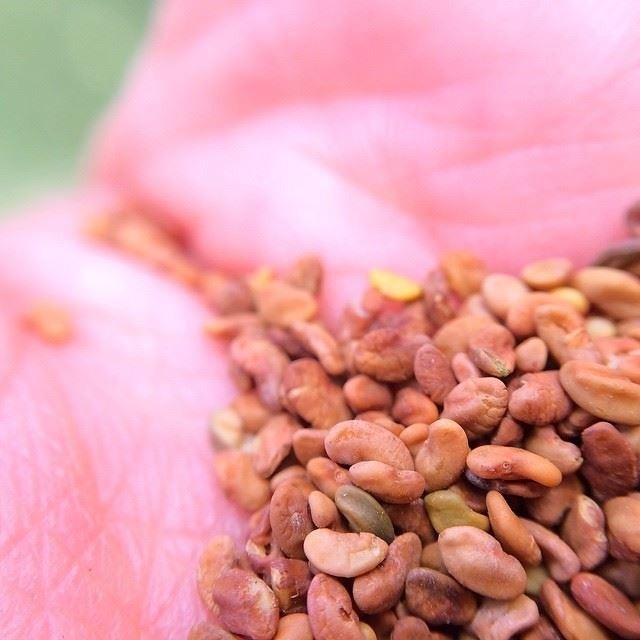Reviewed by Danielle Ellis, B.Sc.May 8 2023
Alfalfa (Medicago sativa), also known as the “King of Grass,” is a legume cultivated in various parts of the world for animal feed. It is highly valued in the feed business because of its high protein content and biomass output.
 Alfalfa seeds often show dormancy and fail to germinate. Scientists in China have now used multispectral imaging, machine learning, and “omics” to reveal the mechanisms behind alfalfa seed dormancy. Image Credit: m7sanchez
Alfalfa seeds often show dormancy and fail to germinate. Scientists in China have now used multispectral imaging, machine learning, and “omics” to reveal the mechanisms behind alfalfa seed dormancy. Image Credit: m7sanchez
Alfalfa protein has recently found use in aquaculture, the pet food industry, and the human diet. It is also regarded as an environmentally friendly crop, with good effects on biodiversity and soil nitrogen conservation.
Alfalfa has two seed types: hard and non-hard, with no discernible distinctions. Unfortunately, the hard seeds cannot be eliminated and offer a substantial economic challenge. Hard seeds have little benefit because they promote sluggish germination, uneven seedling establishment, increased weed competition, and germination failure.
Seed dormancy refers to the delayed germination that occurs after embryogenesis. Hormone-mediated physiological dormancy (PD), hard seededness for physical dormancy (PY), and combinatorial dormancy (PY + PD) are among those thought to have a role in alfalfa seed germination.
Moreover, there is a scarcity of hard seed research in legumes, and until recently, alfalfa dormancy was assumed to be limited to the PY type. Scientists from China Agricultural University’s College of Grassland Science and Technology, headed by Associate Professor Shangang Jia, have discovered the PY + PD pattern in this type of legume using multispectral imaging (MSI) technology combined with “multi-omics” platforms.
The research was published in The Crop Journal on March 31st, 2023.
Studying dormancy in hard and non-hard alfalfa seeds is problematic. Doing comparative research by soaking the seeds in water–a technique called imbibition–is time-consuming and causes the non-hard seeds to germinate. We needed an accurate, non-destructive, and high-throughput approach to gain deeper insights.”
Shangang Jia, Associate Professor, College of Grassland Science and Technology, China Agricultural University
The team created a high-throughput technique for recognizing seeds, comparing dormancy patterns, and analyzing changes in physiology, metabolism, and gene expression in hard and non-hard seeds by merging MSI with multi-omics (transcriptomics, metabolomics, and methylomics) platforms.
The technique could successfully identify hard alfalfa seeds with high accuracy—of up to 100%. Furthermore, the transcriptomics, metabolomics, and methylomics analyses revealed that abscisic acid (ABA) responses played a key role in hard alfalfa seeds.”
Shangang Jia, Associate Professor, College of Grassland Science and Technology, China Agricultural University
ABA, a hormone that promotes dormancy, operates like a sleeping pill, keeping seeds dormant. Furthermore, the degree of seed dormancy is governed by the balance of ABA and other hormones such as indole acetic acid (IAA) and jasmonic acid (JA). Hard seeds were higher in antioxidants and flavonoids, lipids, and hormone biosynthetic pathways than non-hard seeds. Furthermore, enhanced ABA gene expression and differential methylation of ABA-responsive genes in hard alfalfa seeds highlighted the ABA responses.
The researchers also discovered non-PY hard seeds with greater ABA/IAA and ABA/JA levels that did not germinate after being treated to break dormancy. This finding supported the participation of the PD pattern and demonstrated that PY + PD, rather than PY alone, drove the failure of hard alfalfa seeds to germinate.
We believe we've provided a theoretical and technical framework for exploring alfalfa hard seed dormancy, and our findings could certainly guide the optimal processing of these seeds in the alfalfa seed industry!”
Shangang Jia, Associate Professor, College of Grassland Science and Technology, China Agricultural University
The experts are optimistic that their results will have a significant impact on future research and may have enormous economic ramifications.
Source:
Journal reference:
Wang, X., et al. (2023). Multiple omics datasets reveal significant physical and physiological dormancy in alfalfa hard seeds identified by multispectral imaging analysis. The Crop Journal. doi.org/10.1016/j.cj.2023.03.003.